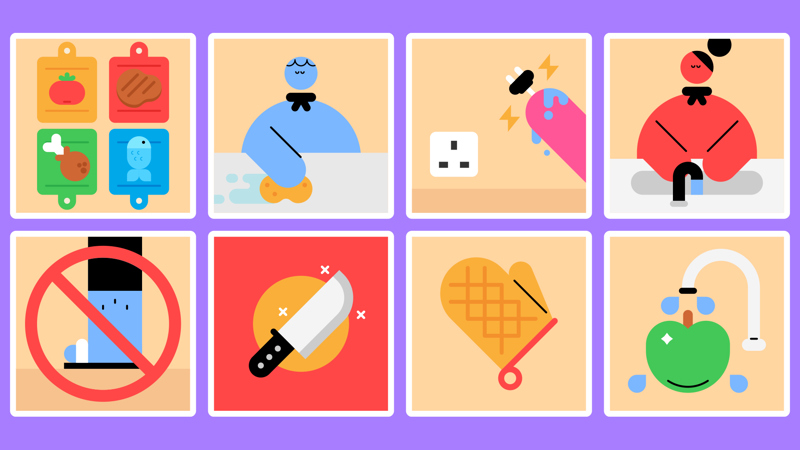
Kitchen risk bingo
You’ll need
- Scissors
- Pens or pencils
- Container (like a bowl or hat)
Before you begin
- Print enough bingo cards from the ‘Tiles and cards’ sheet for every player to have one each.
- Print a copy of all of the possible tiles from the ‘Tiles and cards’ sheet, and cut it up. Fold each of the images, and put them in a bowl, ready to choose from later.
Find the faults
- Split into small groups.
- Half of the groups should think of things in the kitchen which may be dangerous or hazards. For example, they might think about electricity, bacteria, sharp objects, or hot things.
- The other half of the groups should think about things we do to stay safe in the kitchen. They might come up with ideas like wearing oven gloves, washing hands, and wiping surfaces, for example.
- Everyone should come back together. The groups who thought of hazards should take it in turns to name a hazard.
- Groups who thought about things we do to stay safe should put their hands up if they have a safety tip that’s related to the hazard, so they can tell everyone.
- If a group talks about a hazard or safety tip without a match, they should try to figure out how to stay safe around the hazard, or what hazard the safety tip is about.
Play bingo
- Give everyone a bingo card and a pen.
- The person leading the game should take a folded tile out of the bowl, unfold it, and call out what’s on it. Everyone who has that hazard and safety tip on their card should cross it out.
- The person leading the game should keep choosing tiles from the bowl, calling each one out. The players should listen carefully, and cross out the images on their sheet as they’re called.
- When a player has marked a line in any direction (from side to side or top to bottom) they call ‘line!’. When a player has marked off all of the tiles on their card, they call ‘bingo!’. The first player to call ‘bingo!’ is the winner.
- Everyone should talk about the different things on their card. What are the hazards? How do the tips help keep everyone safe?
Reflection
This activity helped you to develop skills. Is being safe in the kitchen a skill? Are you already skilled in the kitchen, or are there more skills you’d like to develop? Which kitchen skills would you like to practice? Do you know how to be clean and safe in the kitchen now? What did you learn during this activity?
This activity also reminded you why it’s important to live healthily. How does following the safety tips keep you healthy? Why is it important to make sure you’re clean and sensible in the kitchen? How else does cooking your own food help you to live healthily (you can add more vegetables, learn about different foods)?
Safety
All activities must be safely managed. You must complete a thorough risk assessment and take appropriate steps to reduce risk. Use the safety checklist to help you plan and risk assess your activity. Always get approval for the activity, and have suitable supervision and an InTouch process.
- Scissors
Supervise young people appropriately when they’re using scissors. Store all sharp objects securely, out of the reach of young people.
- People could organise the rules into the order they’d do them in the kitchen.
- People could do their own research into specific parts of food safety, such as organising food in the fridge or cooking and cooling times.
- People could work in pairs, if they want to.
Be mindful of people’s situations when talking about cooking and eating at home. Use inclusive language, for example, talk about ‘whoever you live with’ rather than ‘your mum and dad’. Be aware that not everyone will have equal access to food, cooking equipment, and kitchen space.
All Scout activities should be inclusive and accessible.

